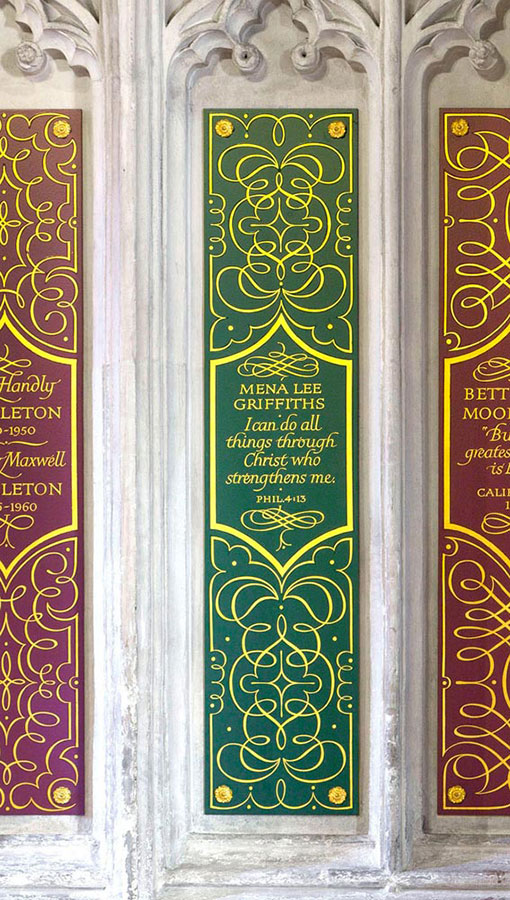Hugh Easton
There are six stained glass windows in Westminster Abbey and its precincts designed by stained glass artist Hugh Easton.
Battle of Britain window
The first of these, to fighter squadrons that took part in the Battle of Britain in 1940, was dedicated on 10th July 1947 in the eastern section of Henry VII's Lady Chapel which was designated the Royal Air Force chapel. The 48-light window commemorates fighter pilots and crew from the United Kingdom, the Commonwealth and other Allied nations who died in the Battle from July to October 1940. In the upper tier are the heavenly Seraphim depicted in brilliant blue and wine coloured glass. The other lights contain the squadron badges and scenes of the Redemption, the Pieta, the Crucifixion and the Resurrection with four depictions of airmen. There are now 70 badges in the window, some which were inadvertently left out in the original design being added in 1961. The faces of the seraphim and of the pilots were based on real life RAF personnel Hugh Neil and Wing Cdr. Gordon Sinclair.
See further information on the RAF chapel, window and key to the badges. (Easton also designed the Battle of Britain window in St George's RAF chapel at Biggin Hill in Kent)
Window in the lower Islip Chapel
On 13th March 1948 the window of the lower Islip chapel was dedicated. This was given by Alan Don, Dean of Westminster, as a thank offering for the safe deliverance of the Abbey and St Margaret's Westminster from the perils of war. This shows Abbot Islip kneeling and St Margaret of Antioch, with blonde hair, killing the dragon, with various coats of arms. The window incorporates a diamond-shaped piece of medieval glass showing the rebus of the Abbot.
Citizens of Westminster window
On 7th November 1948 the window in St Benedict's chapel to Citizens of the City of Westminster who died in the 1939-45 war was dedicated. This shows large figures of St George and St Michael slaying the dragon and symbolises the sacrifice of the citizens who died - in civil defence, the voluntary services, Home Guard, fire, police and armed services.
Nurses memorial window
On 2nd November 1950 the Nurses memorial chapel and window were dedicated. The upper Islip chapel was designated the Nurses' Memorial Chapel to remember all those members of the British and Commonwealth nursing services who died during the Second World War. (It has recently been re-dedicated as the Florence Nightingale memorial chapel). The subject of the Easton window is Our Lady standing on the crescent moon holding the Christ Child, with a figure of St Luke (the beloved physician) standing on a rainbow in the other light with a kneeling nurse at the base. At the top is the lamp of Florence Nightingale and in the base are badges of the various nursing services, with names and coats of arms of all the countries from which nurses came to serve in the conflict.
The cockerel device of the designer is shown - a weather vane with the name H. EASTON and a cockerel on the top - together with the inscription:
This window was designed by Hugh Easton & made by him with the help of Robert L. Hendra & Geoffrey F. Harper assisted by A.E. Wigzell, A.J. Harper, P. Ryall & C.E. Watkiss. It was glazed by T.C. and D. Harris 1950.
This small chapel is not open to the public but application to view can be made to a Verger or Marshal at the Abbey.
Cheyneygates (two windows)
In the part of the Deanery known as Cheyneygates (private room), in the cloister area, are two small windows by Easton. One in the entrance hall shows a wreath of red and orange roses with the inscription "This restoration was completed in the year of the coronation of Elizabeth II Vivat Regina 1953". At the base is written:
The Norman Abbots house enlarged in the 14th century by Abbot Litlyngton and commonly called Cheyneygates was granted on the dissolution of the monastery to Thomas Thirlby first and only Bishop of Westminster in 1541. In 1560 by charter of Queen Elizabeth I it became the Deanery. Here lived successive Deans of Westminster until on May 10th 1941 it was destroyed by enemy action.
A pomegranate is shown in one of the quarries.
A lancet (which can be viewed from the cloister area outside) at the bottom of the stairs shows two roundels with flowers and inscriptions "To me the meanest flower that blows can give thoughts that lie too deep for tears". Between them is a figure of the famous ballerina Dame Margot Fonteyn. Flowers and ballet were two interests of Muriel Don (nee McConnell), wife of Dean Don. The cockerel emblem is shown at the base.
Hugh Easton (1906-1965) was born in London, son of Frank (a doctor) and Alice (Howland). He studied in France and worked for the firm of Blacking in Surrey before setting up a studio in Cambridge. During the Second World War he served at the Ministry of Information with the rank of commander RNVR. Most of his windows were made in Harpenden at the studio of Robert Hendra and Geoffrey Harper. He and his associates worked on many windows for churches and other institutions after the war. A memorial service was held for him in Henry VII's chapel on 24th September 1965.
Further reading
Oxford Dictionary of National Biography
"Stained glass of Westminster Abbey" by Christine Reynolds 2002
"The 100 best stained glass sites in London " by Caroline Swash, 2015
"A life in glass...portrait of a stained glass artist" [about Geoffrey Harper, one of Easton's assistants] by F.Stevens

This image can be purchased from Westminster Abbey Library
Image © 2024 Dean and Chapter of Westminster

This image can be purchased from Westminster Abbey Library
Image © 2024 Dean and Chapter of Westminster

This image can be purchased from Westminster Abbey Library
Image © 2024 Dean and Chapter of Westminster










